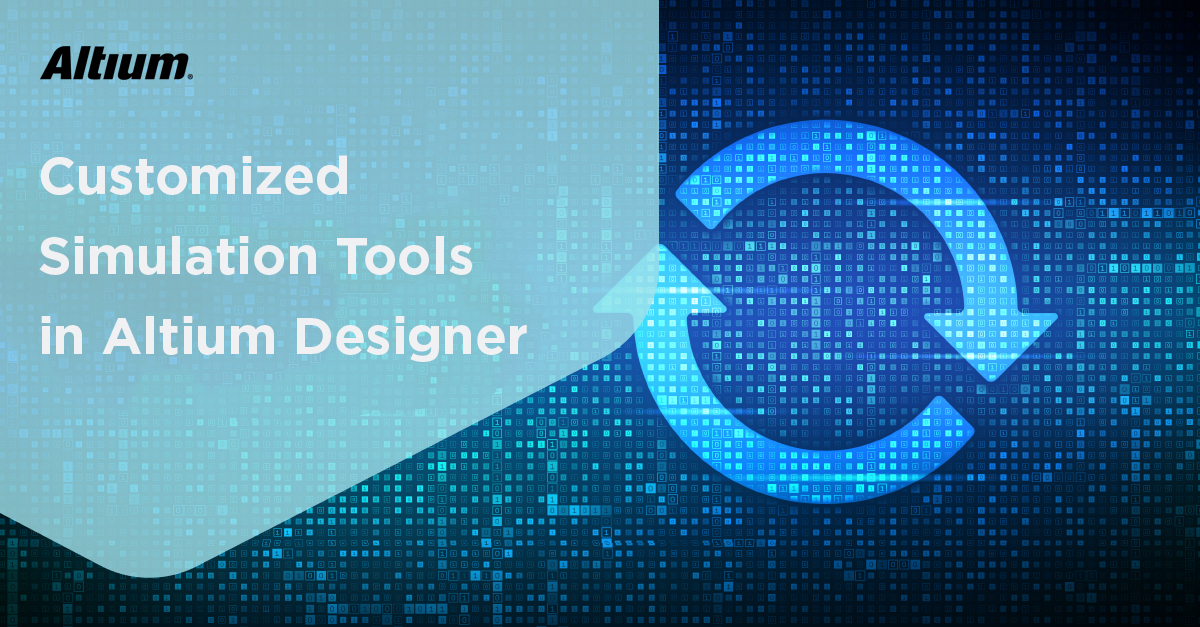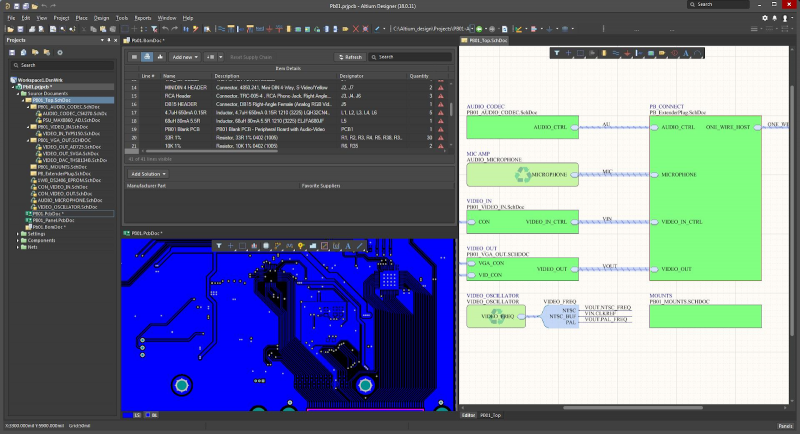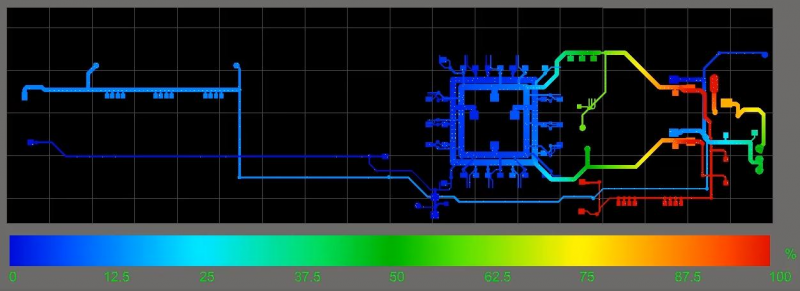PCB Simulation Software with Altium Designer

If your PCB has any kind of functionality involving high speed, high frequency, mixed signals, low current, and/or RF communication, design verification will be critical to ensuring that your device will work as designed. You’ll need access to the best schematic, layout, and component management tools that integrate seamlessly with advanced simulation tools. Simulating circuit board power delivery, signal integrity, thermal analysis, mixed signal simulation, and more are made easy with the PCB simulation tools accessible from within a single environment using Altium Designer - the best PCB design software on the market. Look no further than Altium Designer.
ALTIUM DESIGNER
A PCB design package with extensive tools for engineers building circuit boards, including a robust built-in PCB simulation software.
With so many simulators and simulation techniques for circuits and electronic devices, it helps to have all of these tools gathered in a single place. If you need to verify your design by simulation, you don’t need to spend time moving your design between separate design and simulation software tools. Instead of using expensive PCB design software packages that claim to integrate everything in one place, consider using the only official unified PCB design software package on the market.
Device verification proceeds directly from the board level, and completing this critical step requires a PCB simulator and testing tools that let you address every circuit on your device. More complex devices require more adaptable simulation tools, and there is no reason that you should have to move away from your design program to run these critical simulations and analyze the results. Altium Designer is the only affordable complete PCB design package that links your circuit simulator tools directly to your design within a single interface.
Get the Complete Package: Get Altium Designer
Other PCB design software programs claim to be unified, but they still force you to move between a PCB design module and a Circuit Board simulation module. This is not a truly unified design, and this environment requires multiple unnecessary steps just to perform simple circuit simulations or use the most basic of design tools. Altium Designer is the only truly unified design environment. Everything from design to simulation and advanced analysis is available within a single package.
Design, Simulation, and Component Management Tools All in One Package
When you work in an integrated design environment, there is no need to export from schematic capture or layouts to another simulation program. Your critical simulation tools interface directly with your schematic design and circuit board layout tools. Component functionality, specifications, and logic are all defined in extensive components libraries, and your libraries will automatically update as new components are added. All of this is accessible for your circuits within the Altium Designer.
- Simulations based on your PCB layout require high accuracy CAD tools. Altium Designer makes important design features customizable and lets you place components with unparalleled accuracy. Learn more about the CAD layout tools in Altium Designer.
- The simulation tools in Altium Designer interface directly with your component libraries. You can even create your own components and incorporate them into your libraries.
- All of this occurs in Altium Designer’s unified design model that integrates your design and runs simulation tools within a single software platform. Learn more about the unified platform in Altium Designer.

Altium Designer’s unified design interface
Power Delivery and Signal Analysis in Altium Designer
Most engineers design Printed Circuit Boards to be powered with a DC source, and power delivery in your Circuit Board is vital to ensuring your device works properly. Poor power integrity can be the root cause of many operation problems that are difficult to diagnose. Power integrity problems can lead to signal integrity problems in your Printed Circuit and can cause your circuit board to fail in a pinch. Looking for a SPICE simulation or strong design rule check engine are just two of the ways to resolve your circuit.
A power delivery network (PDN) analyzer can help engineers map voltage drops and current density throughout your device, giving you a full view of how power is distributed in your PCB. Since heat generation and current density are proportional, potential hot spots and rule violations are easily flagged using this tool, making it easy to correct potential problems before your PCB goes up in flames.
Diagnose Power Delivery and Signal Problems in Altium Designer
Large IR drops, current density distribution, thermal hot spots, and more can be calculated using the PDN analyzer tool in Altium Designer. These tools easily integrate with the design and component management tools, providing you with the most accurate power density and signal integrity simulations. Keep your designs running as fluid as your user interface with Altium Designer.
- Simulate power distribution throughout your PCB with the PDN Analyzer in Altium Designer. You can run simultaneous multi-network simulations and build sortable simulation reports. Learn more about the PDN Analyzer in Altium Designer.
- A whole host of issues can cause signal integrity issues in PCBs. You can diagnose signal integrity problems in your device with Altium Designer. Learn more about signal integrity simulation and analysis in Altium Designer.
- Power delivery problems can to thermal issues, which can damage sensitive features like vias and light copper. The PDN Analyzer incorporates thermal analysis, giving you the power to address thermal problems before your device overheats. Learn how to incorporate thermal analysis into your PDN analysis in Altium Designer.

PDNA simulation in Altium Designer
Simulate Any Device in Altium Designer
Design verification through simulation is vitally important in electronics design. With the multitude of ways to design a device, no two simulation models will ever be the same. Furthermore, having strong simulation software backing up your designs allows greater visual displays for team collaboration.
With Altium Designer, you can customize your simulations within an intuitive interface. Mixed-signal simulations, impedance plots, transfer function determination, and many more analyses can be performed within a single environment. This, on top of unified output files, makes it easy to translate results and board designs to any facet of your team.
Customized Simulation Tools in Altium Designer
Working with Altium Designer gives you access to powerful built-in simulation tools that let you simulate any part of your Printed Circuit Boards. You’ll also be able to import simulation models in other industry-standard formats. You can simulate your analog devices with SPICE models, and you can define the functionality of custom digital components with IBIS models. No other PCB design software package integrates so many capabilities into a single environment.
- Now you can create SPICE simulations directly from user data. Setting up a simulation is easy with the SPICE Model Wizard in Altium Designer. Learn more about creating SPICE simulations in Altium Designer.
- Simulating mixed-signal devices is easy in Altium Designer. You can perform a whole suite of analyses within a single tool. Learn more about running mixed-signal simulations in Altium Designer.
- Import custom simulation models and run them directly in Altium Designer. You can define custom models using any number of components. Learn more about editing simulation models in Altium Designer.
Whether you need to simulate a single component, mixed-signal circuits, or identify signal integrity issues, Altium Designer contains all the PCB software tools you need. Download Altium Designer and you’ll have access to all the simulation tools demanded by the Circuit Board design industry.
